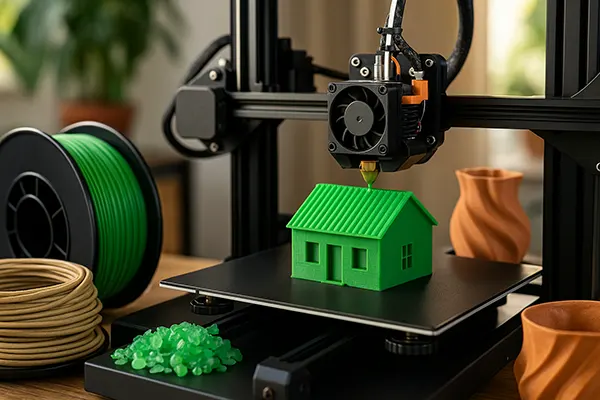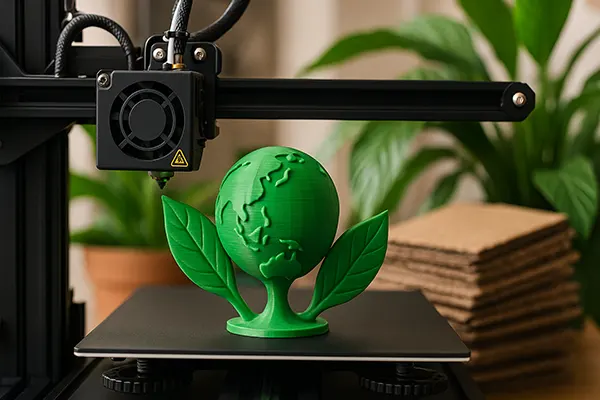
The Life Cycle of 3D Printing: Environmental Responsibility and Sustainable Materials
3D printing, also known as additive manufacturing, has moved far beyond its early experimental phase and now plays a key role in sectors such as medicine, construction, aerospace, and consumer goods. While it offers unmatched opportunities for innovation and customisation, it also raises questions about sustainability, material use, and environmental responsibility. Understanding the full life cycle of 3D printing allows us to assess its ecological footprint and evaluate strategies that can make this technology more responsible and future-oriented.
The Environmental Footprint of 3D Printing
Every stage of the 3D printing process consumes energy and resources. The production of raw materials such as plastics, resins, and metals often relies on industrial processes that emit carbon dioxide and generate waste. Although 3D printing reduces surplus material compared with traditional subtractive manufacturing, it is not free of environmental impact.
Energy consumption is another important factor. High-powered lasers, heated build chambers, and other energy-intensive processes are widely used in industrial 3D printing. As a result, the carbon footprint of certain printing technologies can be significant, especially when renewable energy is not utilised.
Waste generation must also be considered. Failed prints, support structures, and unused powders or resins often end up as waste if they cannot be recycled. This creates a challenge for both hobbyists and large manufacturers seeking to reduce their ecological impact.
Balancing Innovation with Sustainability
Innovation in 3D printing must go hand in hand with responsible practices. Increasingly, researchers and manufacturers are exploring more sustainable feedstocks such as biodegradable polymers, plant-based filaments, and recycled materials. These solutions aim to reduce reliance on virgin plastics and minimise landfill waste.
Energy-efficient printing systems are also gaining momentum. Machines designed to optimise energy usage, alongside the use of renewable electricity, can significantly reduce emissions. Some companies are already integrating solar-powered printing facilities or applying smart energy management systems to lessen their footprint.
Education and awareness also play a crucial role. Designers and engineers need to understand the implications of their material choices and production methods, ensuring they design parts with efficiency, durability, and end-of-life recyclability in mind.
Advances in Sustainable 3D Printing Materials
One of the most promising developments in additive manufacturing is the rise of environmentally responsible materials. Polylactic acid (PLA), a bioplastic derived from renewable sources such as corn starch, has become one of the most popular filaments due to its biodegradability and low toxicity. However, its performance limitations drive the need for continuous innovation in this area.
Recycled filaments, made from waste plastics like PET bottles, provide a circular solution by giving discarded materials a second life. Such materials not only address waste reduction but also lower the carbon footprint associated with virgin plastic production.
In more advanced applications, researchers are investigating bio-based resins, metal powders from recycled scrap, and even sustainable composites reinforced with natural fibres. These innovations demonstrate the potential of 3D printing to align with principles of circular economy and reduce reliance on environmentally harmful resources.
Challenges in Material Sustainability
Despite progress, significant challenges remain. Many sustainable materials still lack the mechanical strength, durability, or heat resistance required for demanding industrial applications. This limits their widespread adoption in sectors such as aerospace or automotive manufacturing.
Additionally, recycling processes for 3D printing materials are not yet fully optimised. While some filaments can be re-extruded, repeated recycling often degrades their quality, leading to weaker prints. Investments in advanced recycling technology are necessary to ensure that sustainable materials remain viable.
Finally, cost remains a barrier. Sustainable materials are often more expensive to produce, making them less attractive to large-scale manufacturers unless supported by regulations, subsidies, or growing consumer demand for eco-friendly products.

Future Perspectives for Responsible 3D Printing
Looking ahead, the role of 3D printing in building a more sustainable economy will depend on both technological and cultural shifts. A focus on life cycle assessments, where each stage of a product’s creation and disposal is evaluated, will become standard practice for manufacturers aiming to demonstrate accountability.
Policy frameworks and regulations are also expected to evolve. Governments and international organisations are increasingly recognising the need for clear sustainability guidelines in manufacturing, including additive technologies. Standards for recyclability, material sourcing, and energy consumption will likely play a defining role.
On a broader scale, consumer behaviour will influence the path of 3D printing. As buyers place greater value on eco-conscious products, companies will be encouraged to adopt greener materials and responsible practices to remain competitive in the global market.
Integrating Circular Economy Principles
The future of 3D printing lies in its alignment with circular economy models. This means designing products for longevity, reusability, and recyclability rather than short-term consumption. By creating systems where materials are continuously reused, the environmental impact of additive manufacturing can be substantially reduced.
Collaboration across industries will be key. Partnerships between material scientists, manufacturers, policymakers, and recyclers can accelerate the adoption of eco-friendly solutions and create sustainable supply chains for 3D printing.
Ultimately, the responsibility lies not only with technology developers but with every stakeholder involved in the life cycle of 3D printing. By working collectively towards sustainability, this transformative technology can contribute positively to both innovation and environmental preservation.
